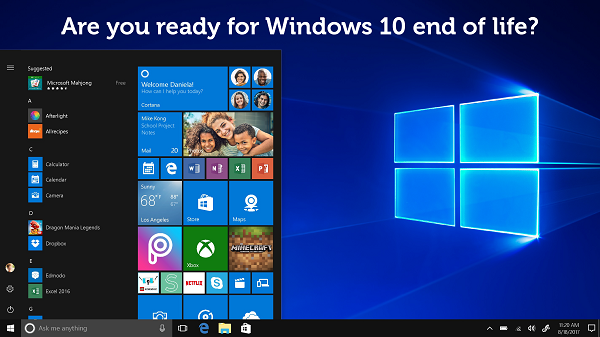Why you must start planning early for Windows 10 end of life

In 2023, Microsoft announced that its Windows 10 operating system will go out of support in 2025. It might seem a long way off but there are important reasons why your organisation should begin to prepare for this event now.
Microsoft explained that Windows 10 will reach end of support on October 14, 2025. The current version, 22H2, will be the final version of Windows 10. Windows Pro (as well as other editions) will remain in support with monthly security update releases through that date.
However, after October 14, 2025 these editions will no longer be supported by Microsoft.
Windows 10 will reach end of support in October 2025
Running an operating system after it has gone out of support is not advisable. After this date, it no longer receives security updates from Microsoft. This leaves it vulnerable to cyber-attack. To ensure your organisation is secure, you will need to move all your users onto a newer, supported version of the operating system.
At the time that Microsoft launched its Windows 10 operating system, some ten years ago, it announced that it would be moving to an operating system as a service model, with regular updates being released through its lifecycle.
However, in 2021 Microsoft launched its Windows 11 operating system. This was received with some scepticism. Although Windows 11 had a new look and feel, it also came with some new hardware requirements which made the decision over whether or not to upgrade from Windows 10 to Windows 11 more complex.
The hardware requirements of Windows 11
To install or upgrade to Windows 11, devices must meet a list of system requirement, including having Trusted Platform Module version 2.0.
This requirement has caused most consternation. Many older PCs and laptops do not support TPM 2.0. There are some workarounds which would allow you to deploy Windows 11 regardless, but Microsoft has been clear that if you choose to do this, the installation comes at your own risk.
The promise of Windows 12
With excitement in the industry around the possible launch of Windows 12 this year, later in 2024, it might be tempting to think you can bypass Windows 11 and move straight from Windows 10 to Windows 12.
However, noises in the tech press suggest that Windows 12 might come with its own set of complications. In January 2024, Digital Trends reported that the new operating system will be focused on enabling AI features.
Windows Central reported that those in the know expect Windows 12 to come with some hardware requirements based on enabling AI capabilities. It is likely to require a dedicated Neural Processing Unit (NPU).
We’re only just beginning to see this hardware reach the market, so requiring an NPU could mean that many older PCs and laptops simply won’t be able to run Windows 12 – or, at least, won’t be able to fully benefit from its features.
It is also worth noting that that the memory requirement for Windows 12 is going to be 16Gb at minimum. This is above the “norm” for many business PCs which are usually 8Gb.
Microsoft is launching AI-enabled Surface devices
One indicator of this likely direction is Microsoft’s development of its own Microsoft Surface devices. In 2024, Microsoft is expected to launch Surface Pro 10 and Surface Laptop 6 with the option of a next-generation NPU.
While some commentators argue that Microsoft won’t want to restrict the next version of Windows to only users who can afford the latest and greatest laptops, thereby making it unlikely an NPU will be a requirement to use the operating system, it is true that hardware expectations are changing rapidly.
Indeed, in order to benefit from the new AI capabilities, you will want to upgrade your hardware anyway sooner rather than later.
Why you need to start preparing for Windows 10 end of life now
The costs associated with an organisation-wide hardware refresh means that every business needs to start preparing for Windows 10 end of life now.
This news will affect a large majority of organisations. That’s because, despite launching nearly three years ago, Windows 11 is still well behind Windows 10 in market share.
According to StatCounter data published in January 2024, at that point in time Windows 10 accounted for 66% of the world's total Windows-based operating system market share. Windows 11 accounted for just 28%.
How can you prepare for Windows 10 end of life now?
There are many compelling reasons to upgrade to Windows 11, including the integration of Microsoft Teams and Power Automate and the new options to deploy Android apps. Users can download the Windows PC Health Check App from the Windows 11 page and find out immediately whether their device is capable of running Windows 11.
If you are in the position of needing a hardware refresh, it makes sense to futureproof those device purchases and prepare for the (expected) requirements of Windows 12 by purchasing devices with NPU chips.
If the numbers of devices which will require an upgrade look prohibitive, we would recommend that you begin investigating leasing costs and arrangements. This is an easy way to upgrade hardware without the prohibitive upfront costs. It will also make meeting any future hardware requirements easier.
Thinking ahead and preparing for 2025 now is vital to ensure the effective cybersecurity defences your organisation needs.
What next?
If you would like more information about any of the operating systems, end of life announcements or hardware specifications discussed in this article, please reach out to our team.
We are always happy to help and offer advice.
Call us: 0808 164 4142
Message us: https://www.grantmcgregor.co.uk/contact-us
Further reading
Find other cybersecurity and technology topics on our blog:
• 2024 Tech Predictions: What cyber security challenges will we be facing in 2024?
• Best practice tips for securing your cloud
• How should risk managers address cyber risk?




